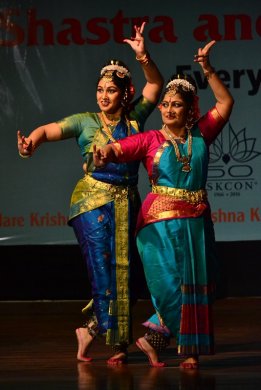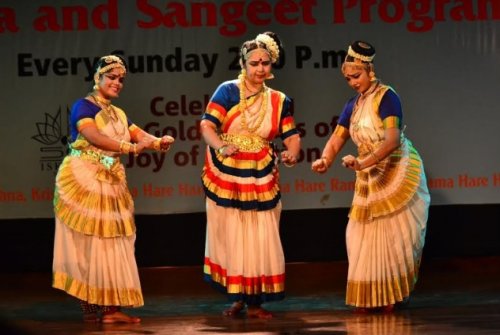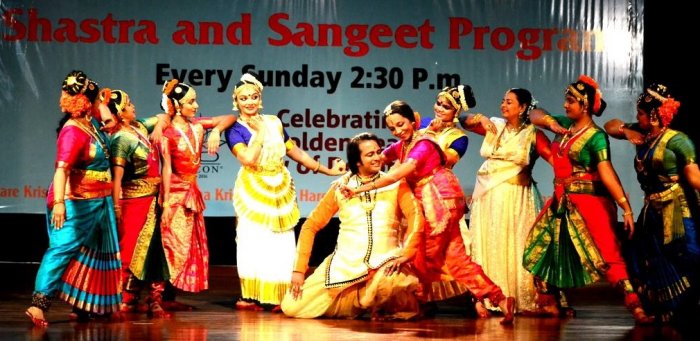
|   |

|   |
Four pathways to godliness - Vijay Shanker e-mail: shankercsn@gmail.com May 28, 2019 Bhakti Kala Kshetra, the cultural wing of International Society for Krishna Consciousness (ISKCON), Juhu, Mumbai, organized an interesting program about a journey back to godhead through Shastra and Sangeet highlighting four pathways to sublime love titled 'Chathurbhavana' interpreting varied forms of devotion through the medium of four distinct classical dance styles, namely Bharatanatyam, Kathak, Kuchipudi and Mohiniattam. It was held at ISKCON auditorium in April end. Conceptualized by Bharatanatyam exponent Lata Surendra, the absorbing production unfolded through four established mentors. Dasya bhavam, servitude through an evocative representation of Saint Meera and Lord Krishna, was sheathed in the kinesthetics of Kathak by Paullumi B Mukherjee and Sunil Sunkara. Through skillful usage of theatre, props and dance they exposed the one to one connection of Meera with her lord. The choice of compositions were apt and Paullumi B Mukherjee as Meera and Sunil Sunkara as Krishna through Dasya bhavam led the audience to a pathway culminating in Meera's ultimate oneness in the lord. The performance dramatized various incidents in the life of Meera when her family turned hostile by poisoning her food, presenting her with a serpent etc but every incident was experienced with sheer devotion to her lord, and hence turned favourable to her. Both Paullomi and Sunil have natural flair for emoting.  Paullomi B Mukherjee & Sunil Sunkara  Sailaja Desai & Sindhuja Desai Sakhyam, friendship through bonding with the lord as a friend was effectively brought to life by Kuchipudi exponent Dr. Sailaja Desai with her disciple Sindhuja Desai. Through suitable sancharis highlighting friendship of Krishna and Gopas, through the concern of the lord for all creation and standing by them as the saviour through his leelas tiding over the changing flux, the friend who could hear the unspoken words and see the burdened heart of his friend Sudama, who could assuage the dilemma of Arjuna in the battlefield of Kurukshetra, the Sakhya bhavam was brought to life. The mother-daughter duo complimented each other. In fact the vibrancy of Sinduja added with the experience of Sailaja saw its climax in the evocative scene of Krishna enacted by Sailaja Desai and Arjuna by Sindhuja Desai.  Geeta V Shankar & disciples Vatsalyam, nurturing quality in the bonding of mother and child was mirrored by Guru Geetha V Shanker and her disciples. The graceful delineation through Mohiniattam depicted skillfully the vatsalyam through Devaki, as she envisaged her child fondly brought up by mother Yashoda. She fondly smiles as she imagines her child to be the lord, that jagadguru, who had come to awaken the world, being lulled to sleep by mother Yashoda through the famous lullaby "Omana thingal kidavo." The lullaby written and composed by poet Irayimman Thampi metaphorically relates all wonders of unfolding creation with the child and even today stands out from other popular lullabies in that it does not at all talk about sleep! The guru and disciples evocatively brought out the vatsalya bhavam highlighting the bonding circle of love between a mother and child. Madhuryam, sublime love, was brought to life by Bharatanatyam exponent, teacher and choreographer Lata Surendra. With an in-depth awareness of the technique and subject, she brought out the immortal essence of the sublime thread binding two souls - Krishnamayi Radha and Radhamayi Krishna. Surendra's choreography touched upon madhuryam, the romantic side of love, where the lovers' hearts beat in rhythm for each other, even when they are far apart. Of that love, where even silences converse, a love that gathers togetherness and forms ultimately the essence of the universe itself. The flowering of the theme and the potency of Bharatanatyam sought a pulsating synergy through the meditated choreography that concluded with Krishna leaving Radha for the waiting mission he had to fulfill. The true hallmark of an artist is when she has the pulse of her audience and Lata immortalized madhuryam through Radha as the 'Dhara -immortal nectar,' who is alluded to as per the lord's dictum as 'Sri Radhakrishna' by devotees for all times.  The group The production concluded with the truth that like rivers, seeking oneness in the ambience of the ocean, each of us through diverse pathways seek to gather oneness in the all-pervading providence. It was a oneness that one saw mirrored through four devotional pathways of bhakti in the chemistry between mentors of various styles, their disciples and the support strength of orchestra members. "If love is the flower, then bhakti is its fragrance," says Lata Surendra. "In order to know the river, you can't just look at it. You need to take a dip in it," she adds, referring to the importance of surrendering unto each defining bond minus dividing walls. The music that was part audio and part live had mellifluous vocals by N.N Sivaprasad, supportive tabla by Rohit, flute by Nandakumar, sound effects by Nandlal Rele and lights by Pednekar. Vijay Shanker is a Kuchipudi and Kathakali exponent, teacher, bilingual journalist, arts critic and actor. |